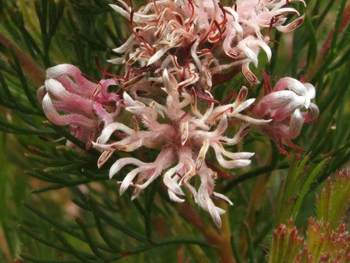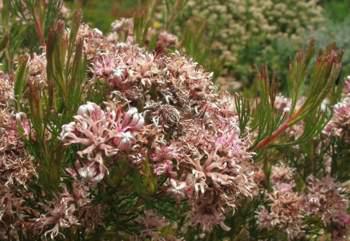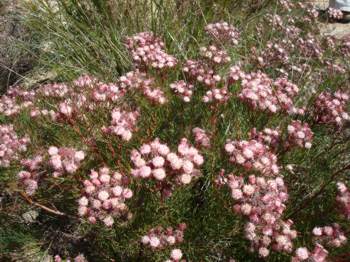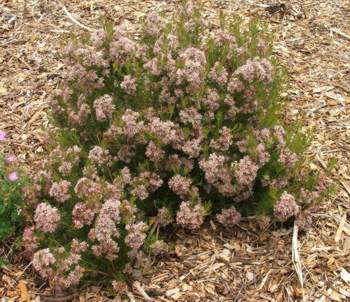Serruria fasciflora
Serruria fasciflora Salisb. ex Knight
Family: Proteaceae
Common names: common pin spiderhead; speldespinnekopbos (Afr.)
Introduction
Serruria fasciflora is a beautiful shrublet that produces sweetly scented, silvery pink flowers all year round; definitely a very rewarding garden subject.

Description
Description
Serruria fasciflora is a sprawling to erect shrublet growing 0.4-1.0m tall and spreading 0.5m. This species is very variable and was previously treated as six separate species based on the differences in the hairiness of the leaves and petals, and the size of the flowerheads.

The finely divided, green leaves are sparsely hairy and curve upwards. The leaves are about 30-70×25-35mm. Clusters with many flowers are borne on short pedicels and are flat-top with 10-15 headlets, each containing 5-7 flowers. The silvery pink flowers are sweetly scented; styles 5-7mm long. The flowers are borne all year round, but mainly from May to December and seeds are released within two month of flowering.
Conservation Status
Status
Serruria fasciflora is Red-Listed as Near Threatened and therefore likely to become at risk of extinction in the near future. It is common on the sand of the West Coast but its habitat loss may be due to the invasion of alien species.
Distribution and habitat
Distribution description
Serruria fasciflora is widespread across flats and mountainous areas from Hopefield on the West Coast, to the Outeniqua Mountains in the east. On the Cape Peninsula it is common on the sands and lower slopes in Muizenberg. Its habitat is extremely variable, with an altitudinal range of 0-610m. It is exposed to hot, dry and windy summers and cool wet winters but will not tolerate frost.

Derivation of name and historical aspects
History
The genus name Serruria was given after Dr James Serrurier, a professor of botany at Utrecht in the early eighteenth century. The specific epithet fasciflorus refers to the clusters of flowers.
Serruria is a genus of 55 species endemic to the Western Cape. Members of the genus can be recognised by their dissected leaves which have cylindrical segments. The spiderheads can be divided into two groups: one group has simple flowerheads, the other group has flowerheads consisting of many headlets. The flowerheads are borne at the tips of branches or in the axils of the topmost leaves. Each flower has a conspicuous floral bract. Serrurias are confined to the winter rainfall area in the Western Cape, extending as far east as Mossel Bay.
Ecology
Ecology
Serruria fasciflora is specifically adapted for pollination by flies hence they are sweetly scented. The common pin spiderhead has adapted to fires in fynbos by reproducing from seed. Seeds are released within two months of flowering and contain fleshy coverings (elaiosomes) that secrete a chemical substance that attracts ants. The ants carry the seeds to their underground nests where the fleshy skins are consumed. The seeds remain underground until conditions are favourable for germination.
Uses
Use
The common pin spiderhead has good horticultural potential as a landscaping plant for fynbos gardens.

Growing Serruria fasciflora
Grow
Spiderheads are not long-lived plants and require replacing every 5-8 years. Serruria fasciflora has a neat habit and does not require regular pruning.
Propagate Serruria fasciflora from cuttings or seed. Cuttings will flower and be ready to plant into the garden a year after propagation while seed will take at least two years before being large enough to plant into the garden.
Take cuttings early in the morning (to prevent wilting) from summer to autumn (December to March). The cuttings should be 30-50mm long from the current season's growth. Dip the cuttings into a rooting hormone powder for semi-hardwood cuttings and plant into a medium of 50:50 polystyrene and finely milled pine bark. Place in the greenhouse with bottom heat (±25°C) and intermittent mist. Once the roots are well developed, remove from the intermittent mist and harden off for 2-3weeks. Transplant into small pots using a well-drained medium made specifically for fynbos plants such as 8 parts bark to 3 parts sand. Ensure the pH is acid to neutral, 6.5 is ideal. Grow on until ready to plant into the garden.
Sow seed late summer to autumn (February to April) when the nights are cool and the days are warm. Dust the seeds with a systemic fungicide and apply smoke treatment. Sow the seed into a seed tray and place in a brightly lit position. Use a well-drained medium consisting of 1 part bark and 2 parts sand; firm down and cover with a layer of sifted sand. Germination can be erratic but should begin after 4-5 weeks. Once two true leaves have appeared, prick the seedlings out into small plugs. Place the seedlings in a lightly shaded area with good air circulation and when the seedlings are ±100mm tall, transplant them into small pots. When growing on, regularly monitor for disease and fungus and treat as necessary. The best time to plant into the garden is at the start of the rainy season (May to August), so that the plants can be established before the dry hot, windy summer arrives.
Before planting apply well-rotted compost to the soil. Feed twice a year during spring and autumn with a low dose of slow-release fertilizer. Choose fertilisers that have little or no phosphorous formula as the Proteaceae species don't like phosphorus. Water early in the morning while the soil is cool to avoid warm moist conditions, as this creates favourable conditions for fungi and bacteria. Apply a thick layer of mulch to keep the soil cool and moist for longer. Serruria fasciflora is best suited to a fynbos garden that has well-drained soil or a sloping aspect. Plant it in full sun in groups of three or more to create a colourful display. Good companion plants include Leucadendron salignum, Thamnochortus cinereus and Erica baueri.
References
- Plants of southern Africa: an online checklist. http:posa.sanbi.org.
- Raimondo, D., Von Staden, L., Victor, J.E., Helme, N.A., Turner, R.C., Kamundi, D.A. & Manyama, P.A. (eds) 2009. Red List of South African plants 2009. Strelitzia 25. South African National Biodiversity Institute, Pretoria. National Botanical Institute, Cape Town.
- Rebelo, T. 1999. West Coast proteas. Field guide to the proteas of the West Coast . Protea Atlas Project, National Botanical Institute, Cape Town.
- Trinder-Smith, T. 2006. Wild flowers of the Table Mountain National Park . South African Flower Guide 12. Botanical Society of South Africa, Cape Town.
Credits
Louise Nurrish & Phumza Bavuma
Kirstenbosch National Botanical Garden
August 2014
Plant Attributes:
Plant Type: Shrub
SA Distribution: Western Cape
Soil type:
Flowering season: Sporadic/All year
PH: Acid
Flower colour: Pink
Aspect: Full Sun
Gardening skill: Challenging
Special Features:
Horticultural zones







Rate this article
Article well written and informative
Rate this plant
Is this an interesting plant?
Login to add your Comment
Back to topNot registered yet? Click here to register.